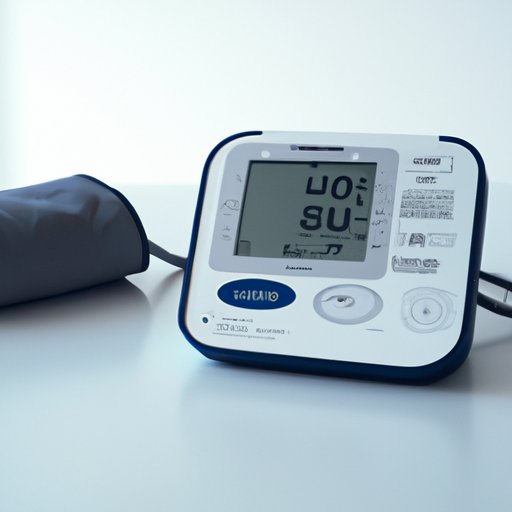
Introduction
Monitoring blood pressure is a critical aspect of monitoring our overall health. High blood pressure, also known as hypertension, affects about one-third of all Americans and is a leading cause of heart disease and stroke. Regularly tracking your blood pressure at home can help you detect any changes and take action before any severe health issues arise. This guide will provide you with a step-by-step guide to measure your blood pressure at home.
Step-by-Step Guide: How to Measure Blood Pressure at Home
To monitor your blood pressure at home, you will need a few essential pieces of equipment: a blood pressure monitor, cuff, and stethoscope. Always make sure that the equipment you are using is calibrated correctly to provide accurate measurements.
Step 1: Sit on a chair with your feet flat on the ground and your back straight. Rest your arm on a table or armrest, ensuring that it is at heart level.
Step 2: Wrap the cuff around the upper part of your arm, about one inch above your elbow. Ensure that the cuff is snug but not too tight.
Step 3: Locate your pulse on the inside of your elbow, on the same side as the arm with the cuff. Place the stethoscope on your arm, over the location where your pulse is the most prominent.
Step 4: Use the pump to inflate the cuff until it is about 30 points above your normal systolic pressure. You can obtain your normal blood pressure readings by keeping track of them over time.
Step 5: Slowly turn the valve on the cuff clockwise to release the pressure. Listen carefully through the stethoscope to hear your pulse.
Step 6: Watch the gauge on the blood pressure monitor, and note when you hear your pulse through the stethoscope. This is your systolic pressure. Continue to release the air, and when you no longer hear your pulse, note the gauge’s reading. This is your diastolic pressure.
After the process is complete, document the readings. To detect any major changes and compare your new measurements with old ones, track your measurements over time.
It is essential to be aware of the interpretation of your readings. Typically, normal blood pressure readings are between 90/60 mm Hg and 120/80 mm Hg. Readings above 140/90 mm Hg are considered high, and immediate medical attention is recommended.
The Importance of Monitoring Blood Pressure and How to Do It Yourself
The most important reason for tracking blood pressure at home is to help prevent hypertension and its severe health impacts such as stroke and heart disease. By measuring your blood pressure at home, you can make lifestyle changes to promote heart health.
To monitor your blood pressure accurately at home, make sure to rest for a few minutes before taking your measurements. Avoid caffeine and alcohol for at least half an hour before measuring your blood pressure. Measure your blood pressure at the same time every day, and choose the same arm for consistent readings.
It is crucial to follow your doctor’s advice on interpreting readings and making lifestyle changes. Lifestyle changes can help you control your blood pressure, such as reducing salt intake, losing weight, and engaging in physical activity.
DIY Blood Pressure Monitoring: Tips and Tricks
Here are some additional tips to help you take accurate measurements at home:
- Make sure your cuff fits properly; your doctor can help you choose the right one for you.
- Avoid talking, moving, or using your phone while taking measurements.
- Use the same arm every time, and avoid using a wrist or finger cuff, which is not as accurate as an arm cuff.
To ensure the proper and accurate positioning of the equipment, consult with your doctor or consider watching an online tutorial on how to use it properly.
Using Technology to Monitor Blood Pressure at Home
With advancements in technology, monitoring blood pressure at home has become more accessible and convenient. There are smartphone apps, wearable devices, and smart blood pressure monitors that allow you to track your blood pressure from the comfort of your home.
Many smartphone apps have features that enable you to track your blood pressure, set reminders for taking your measurements, and send your results to your doctor. Wearable devices such as smartwatches can track your pulse and blood pressure throughout the day, giving you a more comprehensive picture of your overall health.
While technology provides new opportunities for tracking blood pressure, it’s vital to remember that these devices may not be as accurate as medical-grade equipment. Consult with your doctor to help you choose the right device or app to use at home.
Frequently Asked Questions: Home Blood Pressure Monitoring
Here are some of the most frequently asked questions regarding home blood pressure monitoring:
- When should I measure my blood pressure?
- How often should I measure my blood pressure?
- What can I do if my readings are abnormal?
- How accurate are home blood pressure monitors?
- Can I use a wrist or finger cuff instead of an arm cuff?
To obtain and answer these questions, you can refer to the equipment manual or consult with your health care provider for guidance and advice.
Conclusion
The ability to monitor blood pressure at home is a crucial part of overall health and wellness. By taking accurate measurements and regularly tracking your readings, you can detect any changes and make lifestyle changes to promote your heart health. Use the step-by-step guide, tips, and tricks, and other advice provided in this article to help you take control of your health and wellbeing.





